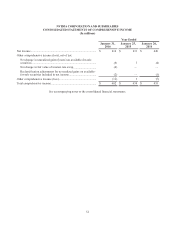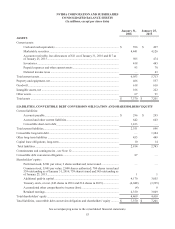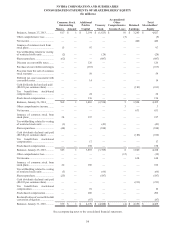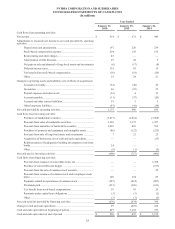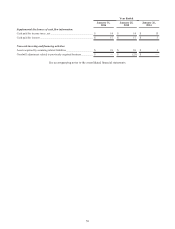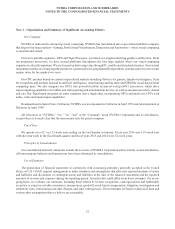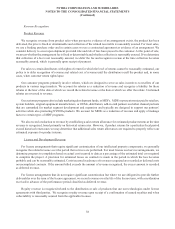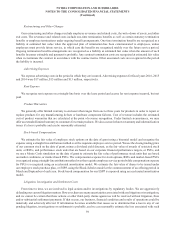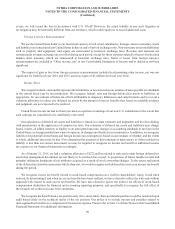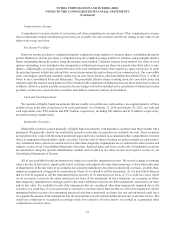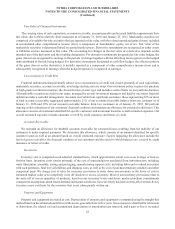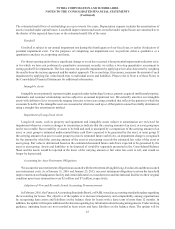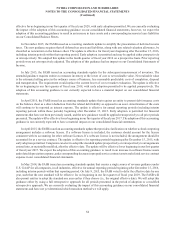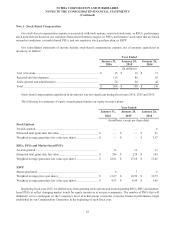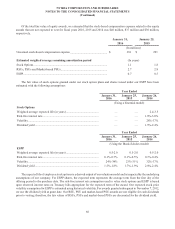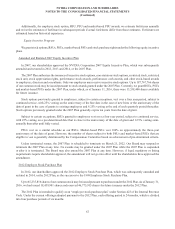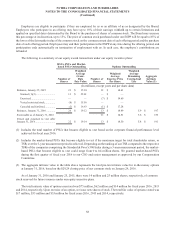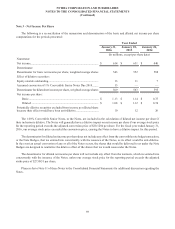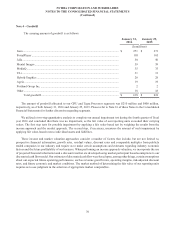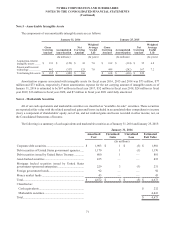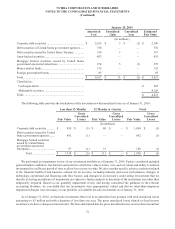NVIDIA 2016 Annual Report Download - page 208
Download and view the complete annual report
Please find page 208 of the 2016 NVIDIA annual report below. You can navigate through the pages in the report by either clicking on the pages listed below, or by using the keyword search tool below to find specific information within the annual report.NVIDIA CORPORATION AND SUBSIDIARIES
NOTES TO THE CONSOLIDATED FINANCIAL STATEMENTS
(Continued)
62
Fair Value of Financial Instruments
The carrying value of cash equivalents, accounts receivable, accounts payable and accrued liabilities approximate their
fair values due to their relatively short maturities as of January 31, 2016 and January 25, 2015. Marketable securities are
comprised of available-for-sale securities that are reported at fair value with the related unrealized gains (losses) included
in accumulated other comprehensive income (loss), a component of shareholders’ equity, net of tax. Fair value of the
marketable securities is determined based on quoted market prices. Derivative instruments are recognized as either assets
or liabilities and are measured at fair value. The accounting for changes in the fair value of a derivative depends on the
intended use of the derivative and the resulting designation. For derivative instruments designated as fair value hedges, the
gains (losses) are recognized in earnings in the periods of change together with the offsetting losses (gains) on the hedged
items attributed to the risk being hedged. For derivative instruments designated as cash-flow hedges, the effective portion
of the gains (losses) on the derivatives is initially reported as a component of other comprehensive income (loss) and is
subsequently recognized in earnings when the hedged exposure is recognized in earnings.
Concentration of Credit Risk
Financial instruments that potentially subject us to concentrations of credit risk consist primarily of cash equivalents,
marketable securities, accounts receivable, note hedge and interest rate swap. Our investment policy requires the purchase
of high grade investment securities, the diversification of asset type and includes certain limits on our portfolio duration.
All marketable securities are held in our name, managed by several investment managers and held by one major financial
institution under a custodial arrangement. Accounts receivable from significant customers, those representing 10% or more
of total accounts receivable, aggregated approximately 21% of our accounts receivable balance from one customer as of
January 31, 2016 and 30% of our account receivable balance from two customers as of January 25, 2015. We perform
ongoing credit evaluations of our customers’ financial condition and maintain an allowance for potential credit losses. This
allowance consists of an amount identified for specific customers and an amount based on overall estimated exposure. Our
overall estimated exposure excludes amounts covered by credit insurance and letters of credit.
Accounts Receivable
We maintain an allowance for doubtful accounts receivable for estimated losses resulting from the inability of our
customers to make required payments. We determine this allowance, which consists of an amount identified for specific
customer issues as well as an amount based on overall estimated exposure. Factors impacting the allowance include the
level of gross receivables, the financial condition of our customers and the extent to which balances are covered by credit
insurance or letters of credit.
Inventories
Inventory cost is computed on an adjusted standard basis, which approximates actual cost on an average or first-in,
first-out basis. Inventory costs consist primarily of the cost of semiconductors purchased from subcontractors, including
wafer fabrication, assembly, testing and packaging, manufacturing support costs, including labor and overhead associated
with such purchases, final test yield fallout, and shipping costs, as well as the cost of purchased memory products and other
component parts. We charge cost of sales for inventory provisions to write down our inventory to the lower of cost or
estimated market value or to completely write off obsolete or excess inventory. Most of our inventory provisions relate to
the write-off of excess quantities of products, based on our inventory levels and future product purchase commitments
compared to assumptions about future demand and market conditions. Once inventory has been written-off or written-down,
it creates a new cost basis for the inventory that is not subsequently written-up.
Property and Equipment
Property and equipment are stated at cost. Depreciation of property and equipment is computed using the straight-line
method based on the estimated useful lives of the assets, generally three to five years. Once an asset is identified for retirement
or disposition, the related cost and accumulated depreciation or amortization are removed, and a gain or loss is recorded.


